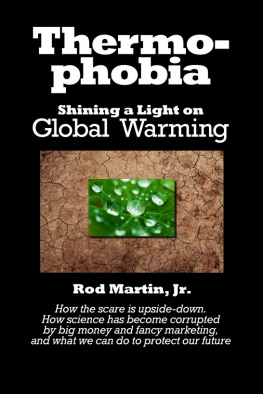Rod Martin - Thermophobia
Here you can read online Rod Martin - Thermophobia full text of the book (entire story) in english for free. Download pdf and epub, get meaning, cover and reviews about this ebook. publisher: Tharsis Highlands, genre: Art. Description of the work, (preface) as well as reviews are available. Best literature library LitArk.com created for fans of good reading and offers a wide selection of genres:
Romance novel
Science fiction
Adventure
Detective
Science
History
Home and family
Prose
Art
Politics
Computer
Non-fiction
Religion
Business
Children
Humor
Choose a favorite category and find really read worthwhile books. Enjoy immersion in the world of imagination, feel the emotions of the characters or learn something new for yourself, make an fascinating discovery.
- Book:Thermophobia
- Author:Rod Martin / Jr
- Publisher:Tharsis Highlands
- Genre:
- Rating:4 / 5
- Favourites:Add to favourites
- Your mark:
- 80
- 1
- 2
- 3
- 4
- 5
Thermophobia: summary, description and annotation
We offer to read an annotation, description, summary or preface (depends on what the author of the book "Thermophobia" wrote himself). If you haven't found the necessary information about the book — write in the comments, we will try to find it.
Thermophobia — read online for free the complete book (whole text) full work
Below is the text of the book, divided by pages. System saving the place of the last page read, allows you to conveniently read the book "Thermophobia" online for free, without having to search again every time where you left off. Put a bookmark, and you can go to the page where you finished reading at any time.
Font size:
Interval:
Bookmark:
Rod Martin, Jr.
Climate is what on an average we may expect,weather is what we actually getAndrew John Herbertson,Outlines of Physiography, circa 1901.
Dedicated to my loving wife, Juvy
Smashwords Edition
December 2018
Published by Tharsis Highlands Publishing
Copyright 2016, 2018 Rod Martin, Jr.
All rights reserved, including the right toreproduce this book, or portions thereof in any form.
Cover photos: Petr Kratochvil viapublicdomainpictures.net. Cover design by Rod Martin, Jr.
On the cover, the dry, cracked earth signifiesdesert-like conditions to be found on an ocean-covered planet thatis too cold. The green life with dew signifies lush conditions tobe found on an ocean-covered planet that is warm or even a littlehot. Life thrives in warmth and dies in the cold.
This ebook is licensed for your personalenjoyment only. This ebook may not be re-sold or given away toother people. If you would like to share this book with anotherperson, please purchase an additional copy for each recipient. Ifyoure reading this book and did not purchase it, or it was notpurchased for your use only, then please return to Smashwords.comand purchase your own copy. Thank you for respecting the hard workof this author.
~~~<>~~~
Dirt Ordinary: Shining a Light onConspiracies, by Rod Martin, Jr.
Favorable Incompetence: Shining a Light on9/11, by Rod Martin, Jr.
Thermophobia: Shining a Light on GlobalWarming, by Rod Martin, Jr.
Climate Basics: Nothing to Fear, by RodMartin, Jr.an Amazon #1 Bestseller
Deserts & Droughts: How Does Land EverGet Water? by Rod Martin, Jr.
~~~<>~~~
~~~<>~~~
One of thebrightest gems in the New England weather is the dazzlinguncertainty of it.Mark Twain, speech to the New England Society,December 22, 1876
Thermophobia is a fear of warmtha disease whichhas gripped much of the planet in recent years. Every fear aboutglobal warming will be cured in this book. We will use facts,logic, science and a sense of perspective that has been sorelymissing from much of the mainstream media. Dont misunderstandthis. Caring about the planet and our future is the foundation ofthis book.
Let us start with some simple questions.
Do you fear cuddling? Do you shake in terrorover the idea of wrapping up in a warm blanket on a cold, rainy orsnowy night? Does the notion of a warm bath or shower send chillsup your spine? And do you stand frozen in horror thinking aboutsitting down to a nice, hot meal?
No?
Then why has civilization gone suddenly bonkersover a rise in average global temperature of 5.4 F (3 C) overthe next century? Thats a temperature difference some peoplewould be hard pressed to discern. Thats a yearly increase of only0.06 F (0.035 C), barely enough to be measurable by most and feltby none. When a similar, natural rate of warming delivered us fromthe frozen horrors of the Little Ice Age, no one complained.
Lets do some comparison.
Downtown Los Angeles has a coastal,Mediterranean-type climate with an average daily high in the rainymonth of February of 68.6 F (20.3 C) and an average daily low of49.3 F (9.6 C). This gives us a daily range of about 19.3 F(10.7 C). Frightening! Thats more than three times thedreaded increase foretold by the United Nations. But the people inSouthern California dont seem to mind. And thats once a day,every day in February. And thats a minor fluctuation, dampened bythe weather and proximity to the Pacific Ocean.
Phoenix, Arizona has an inland, high desertclimate with an average daily high in dry June of 103.9 F (39.9C) and an average daily low of 77.7 F (25.4 C). This gives us adaily range of a whopping 26.2 F (14.5 C). Terrifying! Andyet Phoenix has been such a magnet, its population has grown fromnearly 107,000 in 1950 to over 1.4 million in 2010an increase ofnearly 14 times. When my younger brother, Terry, worked for the USPostal Service, he told me they were opening up a new route or twoevery month just to keep up.
Over a twelve-month period, every year,temperatures in Los Angeles vary from an average low of 47.5 F(8.6 C) to an average high of 84.4 F (29.1 C). Thats amind-numbing yearly change of 36.9 F (20.5 C)nearly seventimes the UNs horror story.
For the yearly changes in Phoenix, we might justblow a gasket. Temperatures there vary from an average lowof 44.8 F (7.1 C) to an average high of 106.1 F (41.2 C).Thats a yearly change of 61.3 F (34.1 C)every year, over eleventimes the global warming scare story. People in Phoenix are notfreaking out over this amount of yearly temperature change. Maybethey know something the UN doesnt.
Climate is a complex, non-linear system which isglobally stable and locally unpredictable. This means that theentire planet will experience changes gradually. Simple inputs,however do not necessarily have simple outputs. Increase the watervapor worldwide, and you will tend to increase the potentialrainfall overall, but the rainfall at any one location will remainunpredictable. But even that effect is not simple. Global warmingwill cause more evaporation from the oceans, but it will alsoresult in the air being able to hold more water vapor before itprecipitates as rain or snow. Non-linear simply means that theeffects are displayed as curves on graphs rather than straightlines. Some of those curves can be quite complex.
Also, there are many things we do not yet knowabout the processes and effects within the climate and weathersystems. We dont yet know the sensitivity of temperature changewith changes in carbon dioxide. The paleoclimatic record tends toshow that temperature has a relatively low sensitivity to changesin CO2, but thats only a qualitative assessment. Wedont yet know the exact quantity of this sensitivity. Thus, UNclimate models will continue to yield outputs which do not matchreality. Also, we do not yet know all of the factors which changeclimate. For instance, were still studying the processes by whichclouds are formed and their effect on overall climate.
More questions!
Where do most people want to vacationsnow orbeachcold climate or warm? Where do New Yorkers like to retire, ifthey have the moneyGreenland or Florida? Which provides a morehospitable environment for growing cropscold or warm? Where are wemore likely to grow the food to feed millionsAntarctica orJava?
If youve been paying attention to the worldaround you, likely you will give the warmer answer for each ofthese questions. This seems to be almost a no-brainer, yet the newsand government reports are awash with the horrors of globalwarming! Thus the ironic term, thermophobiaa fear ofwarmth.
In 2013, according to Mike Schneider ofBusiness Insider, an estimated 537,000 residents moved toFlorida and 10% of them were from New York stateor about 54,000.An estimated zero residents moved to Greenland. Certainly, realestate is far cheaper in Greenland, but facilities andinfrastructure are largely nonexistent there. The infrastructure ismissing, because the demand is near nonexistent. Warmer climatestrump colder ones by a vast margin.
When we compare the population density ofvarious latitudes, we see a clear correlation. Southern UnitedStates, including California, Oklahoma, Tennessee, North Carolinaand states farther south, have an average density of 49.02 peopleper square kilometer. Northern states have an average populationdensity of 28.48 people per square kilometer. Southern Canada has6.82 people per square kilometer, while Northern Canada drops to0.16 people per square kilometer. The gradation is clear. Peoplelike it warmer.
Font size:
Interval:
Bookmark:
Similar books «Thermophobia»
Look at similar books to Thermophobia. We have selected literature similar in name and meaning in the hope of providing readers with more options to find new, interesting, not yet read works.
Discussion, reviews of the book Thermophobia and just readers' own opinions. Leave your comments, write what you think about the work, its meaning or the main characters. Specify what exactly you liked and what you didn't like, and why you think so.










